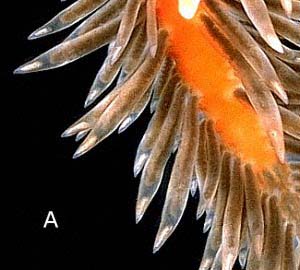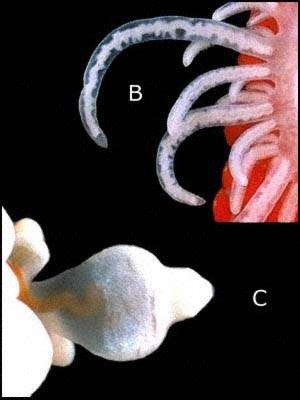

Cerata (ceras) in aeolids
PHOTO
A. Cerata of Aeolidiella foulisi showing brown duct of the digestive gland and whitish cnidosac at the tip. There is a fine duct connecting the cnidosac to the digestive gland duct.
B. Cerata of Phyllodesmium serratum showing some branching of the digestive gland duct and the terminal gland sac, characteristic of this genus.
C. Inflated ceras of Eubranchus inabai.
PHOTOS: Bill Rudman.
The name CERAS (plural CERATA) is from the classical Greek word keratos = horn and is a reference to its shape.
All aeolids have these dorsal and lateral outgrowths of the body. They are a blood-filled tube which contains a duct of the digestive gland. At the tip of the ceras in most aeolids is a sac, called the cnidosac which stores stinging nematocysts from the cnidarians (sea anemones, hydroids etc) on which they feed. Aeolids can discharge these nematocysts in their own defence. Some aeolids, such as species of Phyllodesmium which feed on soft-corals, do not have a cnidosac because the nematocysts of soft-corals are of little use in defence. Instead their cerata produce a sticky secretion at the tip of the ceras. Species of Phyllodesmium are able to break off their cerata when attacked. Look at the page on autotomy for more information on this form of defence.
Cerata come in many different shapes. While most are tapering and tubular, those of Eubranchus are very inflated, and others, such as in Phyllodesmium longicirrum are large and flattened. One remarkable example, Cuthona kuiteri has secondary papillae to make it look like a hydroid polyp. In most species the digestive gland duct is an unbranched duct lined with digestive gland cells, but in a few cases, especially in the genus Phyllodesmium, the digestive gland duct is very branched.
In many species, with transparent or translucent skin on the cerata, much of the colour of the animal depends on the colour of the digestive gland, which can change when the colour of the food it eats changes. (See the page on colour camouflage, and Favorinus japonicus.
It is not possible to suggest a single function for the aeolid ceras. As a thin-walled sac of blood it has a major function as a gill, and with a branch of the digestive gland it provides an ideal organ for the exchange of gases and molecules into, and out of, the blood system. The cnidosac also makes it an important defensive organ. Its ability to change colour also assists it in camouflage.
Other nudibranchs have similar stuctures which are sometimes called cerata but they have evolved quite independently. To compare the cerata of an aeolid with the cerata of a sacoglossan such as Stiliger smaragdinus is like comparing the wing of a bat and a bird.
Authorship detailsRudman, W.B., 1999 (July 1) Cerata (ceras) in aeolids. [In] Sea Slug Forum. Australian Museum, Sydney. Available from http://www.seaslugforum.net/find/ceras
Related messages
Information on Cerata
March 4, 2000
From: Lydia Childress
I am a senior at Indiana Wesleyan University and am doing a 45 min. presentation on the cerata of the eolids pertaining to their ability to breathe through them and defence mechanisms that occur because of them. I would very much appreciate any specific info on these things, especially the the breathing related to the specific physiology that takes place. Any physiological material in this area would be helpful. I have found this site to be the most helpful of anything I have found so far, but still need more. Thank you very much!
Lydia Childress
Lchild99@yahoo.com
Childress, L., 2000 (Mar 4) Information on Cerata. [Message in] Sea Slug Forum. Australian Museum, Sydney. Available from http://www.seaslugforum.net/find/2023Dear Lydia,
The way to find information on the Forum is to use the buttons on the navigation bar at the top of each page. If you go to the General Topics Index you will find things of general interest including a page on cerata and a number of pages on defence.
Be sure to look at the messages at the bottom of each page because they contain much more information.
You can also use the SEARCH button.
Hope this helps you find what you are after,
Good Luck with your project,
Bill Rudman.
